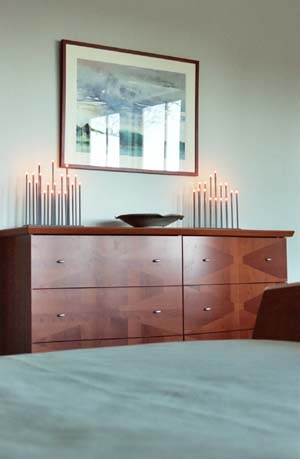After decades of larger and larger house sizes, with rooms for every possible function; society is at last seeing a return to homes being designed on a smaller scale. Attention to small details, space usage and an awareness of human scale is again key. This relates not only to the configuration of the floorplans, but also to how furnishings sit within the space. Creating a home that draws on these sensibilities, no matter what the style, relies on the same principles; balance, proportion, focal point and color coordination.
1. Balance
Balance creates harmony by keeping the visual weight of pieces consistent as one looks across or into a room. If using a tall furniture piece in a room, balance it visually with a tall window, or a lower piece with artwork above it. Balance a sofa with a pair of chairs, or a loveseat in combination with a table. All pieces should not be tall or short, but used in a combination to engage the onlooker and invite them into the space. Balance helps the eye dance around the room and appreciate each piece. This element is easier to achieve when furnishings are in proportion to one another and the room they are used within.
2. Proportion
Proportion goes hand in hand with scale; the size and demeanor of a piece. Proportion deals with how furnishings interact with one another. Taking the earlier examples; the tall furniture piece needs to be a similar height to the windows. The artwork above the lower piece needs to be large enough so it is not “floating” over it. A pair of paintings or a set of four smaller ones would give the same proportion or effect. The pair of chairs balancing the sofa should be of comparable size, but need not be the same style or fabric. When these characteristics work together it has a calming effect. It also creates groupings for the eye to look at, with space between for rest.
3. Focal Point
A room generally has one grouping that grabs attention, known as a focal point. Keeping things simple will help establish what pieces are to be showcased. The rest of the room is then built around these areas of interest. A focal point could be a fireplace, a piece of artwork, a textural wallhanging or a large piece of furniture such as an armoire or a bed. Often the color scheme for the room begins with colors from this special piece.
4. Color
Color has great influence over our emotions and how we react in certain rooms. Cool colors like blues and greens recede and make rooms feel larger and calmer. Bedrooms painted in these colors induce sleep and restfulness. Warm colors like yellows and reds energize a room and make it feel cozy. Red stimulates the appetite and using the right shade, is a wonderful color for a diningroom. When choosing color combinations that work, look to nature. With all that changes in the seasons, there are more schemes than one could ever use in a lifetime of rooms.
By using these guidelines, creating spaces more in tune with the way we want to live our lives becomes easier and more simplified.






